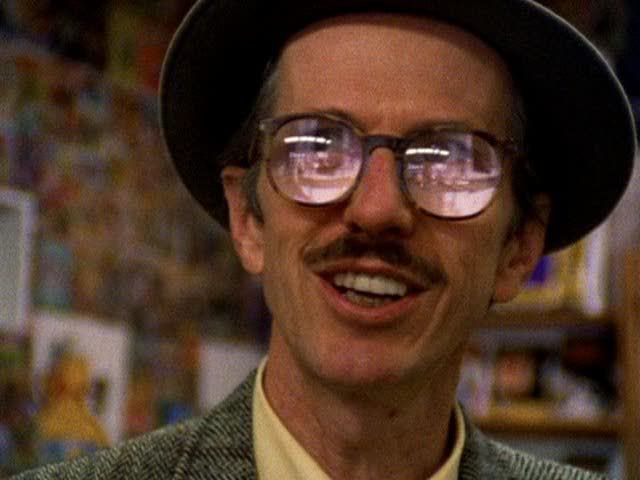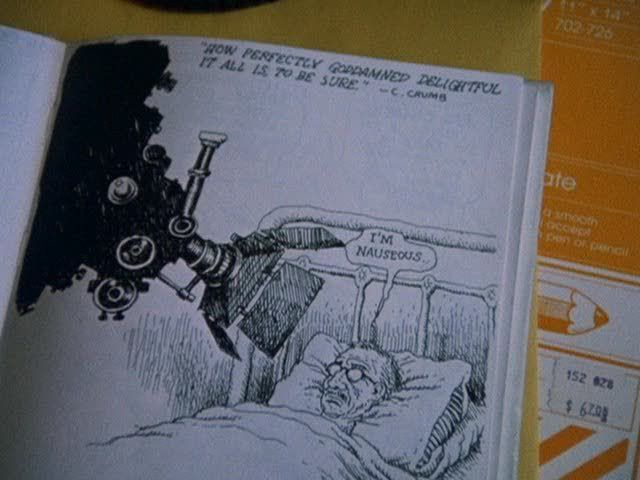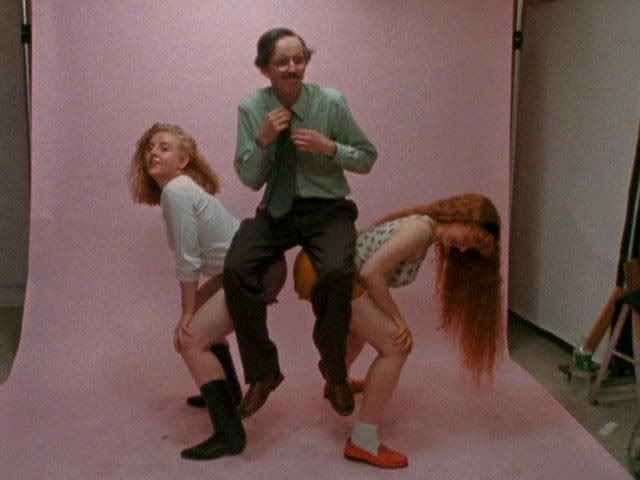
There is no artist in comics more confounding and fascinating than Robert Crumb. He is a central figure to the artform as it has developed in the last fifty years; arguably, he is the central figure without whom comics would not have developed in quite the same way that they have. His work is inescapable for those interested in all sorts of strains within modern comics: he popularized autobiographical storytelling, particularly of the nakedly confessional kind; he was a driving force behind the development of underground, independently published books; he influenced several entire generations of cartoonists with his combination of pristine draftsmanship and an untethered id, fearlessly exploring sexuality and perversions of all kinds alongside pointed political and social satires. And yet his work is simultaneously a challenge to the very concept of good taste; Crumb could always be counted on to draw and write about the things that no one else would even think, or if they did, that they would never dare to let out in public. His work is a catalog of his often grotesque and horrifying obsessions, his fetishized sexuality, his broad misanthropic tendencies, his ranting intolerance for most of his fellow humans, his rage and depression and ugly emotions. There are few artists in comics who draw as well as Crumb — as realistically or as expressively — and there are few whose subject matter is so frequently off-putting and offensive. His work is both thought-provoking and queasiness-inducing.
It might be expected, with such an unrepressed and confessional artist, that there would be nothing left to document. Why make a film about a man who has essentially poured his deepest, darkest thoughts and most potentially incriminating ideas out onto the page, then published it all for anyone to see? And yet Terry Zwigoff's remarkable documentary Crumb manages to be startling and revelatory even for those intimately familiar with its subject's body of work. Zwigoff is a sympathetic but relatively objective biographer, clearly fascinated by Crumb's art and yet also in some sense grappling with it, trying to understand it and the man behind it, with all of his contradictions and openly unpleasant characteristics. Zwigoff never flinches away from Crumb or his disturbing, complicated art. He seems to be circling around his subject, trying to see him from as many angles as possible. There are interviews with art critics and fellow cartoonists who have various wildly contradictory perspectives on what Crumb is doing with his art. There is, of course, a great deal of time spent in the company of Crumb himself, watching him draw, walk the streets and people-watch, or interact with his wife (and sometimes collaborator) Aline Kominsky-Crumb and their daughter Sophie (who has since grown up to be a cartoonist herself). There are interviews with several of the artist's ex-girlfriends, usually while Crumb himself is awkwardly, uncomfortably sitting nearby, and candid conversations with his first wife Dana and their son Jesse. Most importantly, though, and most revealingly, there are the scenes that take up the bulk of the film, dealing with Crumb's complex and tortured relationship with his mother and his two brothers, Charles and Maxon.

To see Robert, Charles and Maxon Crumb speaking about their childhood is to understand, in a sudden, unavoidable flash of insight, exactly the forces that conspired to create the artist that Crumb has become. The three of them grew up almost unnaturally close together in rotten, abusive household. All three slept in the same bed until they were sixteen, and they were virtually inseparable, playing imaginative games (mostly concocted by the domineering Charles) and even drawing comics together, creating an elaborate fantasy world centered around the Disney movie Treasure Island. They grew up with a depressive, perpetually scowling and occasionally abusive father and an amphetamine addict mother, prone to wild mood swings and violent, manic behavior. In this atmosphere, the three brothers seem to have retreated into art for as long as their childhoods lasted. What is striking, though, is the different paths they took once they grew up.
Charles, who says he was possessed by constant homicidal urges — he describes suppressing the desire to stab Robert in the head with a butcher knife, as Robert laughs uncomfortably — essentially withdraws from the world after a brief period of wildness. He sits alone in his room at home, still living with his mother, self-medicating with tranquilizers and compulsively re-reading the same books that he had once read as a child. His art, so expressive and vital even in the childhood comic books that Robert has saved, was confined to his pre-pubescent years, tapering off and then ceasing altogether as he grew older. In one of the film's most poignant scenes, Robert flips through one of Charles' old books, admiring the dark beauty of the drawings in these bastardized Treasure Island tales, the weird textures that Charles layered over everything he drew. Towards the end of the book, as Charles became less and less interested in drawing, more isolated in his own hermetic world, the drawings become smaller and the word balloons larger, until finally there are just pages of cramped, tiny text that verges on unreadability; Robert sadly closes the comic.
Maxon is an equally interesting case. He speaks with casual honesty about the "phase" in his life when he liked to molest women in the streets, though he insists that he stopped short of rape. When Zwigoff and Robert speak to him, he has become involved in a strange quasi-spiritualism that involves sitting on a bed of nails and ingesting a long rope of cloth intended to clean out his insides. Unlike Charles, he still makes art, creating warped, Cubist paintings that bear some obvious relationship to the styles of his two brothers, but are nevertheless inflected with his own frightening sensibility. It is like the odd, unsettling savant work of a mental patient, and the interviews with Maxon — who is inexplicably missing one eyebrow and has an unbalanced appearance as a result — do little to dispel the sensation of barely modulated insanity. Zwigoff's primary accomplishment in this film is to put the most famous Crumb into the context of his familial life, making it clear that Robert, however deviant and unfettered his art can often seem, is the sane one in his family, the only one of the three equally troubled brothers who has managed to successfully sublimate his sexual hang-ups and instability into art while maintaining a hold on the real world.

The film is equally interesting for the way it grapples with Crumb's sexual perversity and what the artist himself has described, in a famous story, as his "troubles with women." Crumb has often been labeled a misogynist, someone with a great deal of aggression and negative feelings towards women, and it's difficult to completely deny the charge. The film goes into great depth in documenting one of his most offensive and hateful stories, in which the manipulative guru character Mr. Natural decapitates a woman and walks her body around to be used as a sexual toy; it could not be any more blatant in its depiction of women as sex objects and its disregard for female intellect if it was an illustrative example in a feminist textbook. Not all of Crumb's work is so nakedly aggressive and creepy, but he returns again and again to his fetishized depictions of female bodies, his repetitive fantasies about powerfully built, muscular, Amazonian women. The weedy, nerdy, buck-toothed Crumb is a Freudian's dream patient, a bundle of psychosexual neuroses with obvious mommy issues: he wants to be simultaneously dominated by a powerful female archetype, and to dominate her in return.
Crumb makes no excuses for the blatantly sexual and exploitative nature of his art, and neither does Zwigoff. The film is not an apologia for the misogynistic elements of Crumb's work, and Zwigoff does an excellent job of situating these comics in multiple critical perspectives. These range from the gushingly admiring to the cautiously conflicted to feminist distrust and disgust. At times, the film even seems to be poking fun at those who attempt to intellectualize and rationalize Crumb's profoundly irrational art. When Time magazine art critic Robert Hughes, the most consistent Crumb admirer in the film, is told that Crumb masturbates while looking at his own work, he launches into a lengthy and somewhat tortured monologue trying to find an artistic justification for this behavior, grasping at explanations for the artist's treatment of his own work like pornography. Once he finally runs out of steam, he laughs nervously and then looks into the camera, earnestly asking, as though he doesn't really believe it, "does he really do that?" Well, yes, he does, at least if you believe the perpetually over-honest Crumb, and in any event it's obvious that on some level these stories are sexual fantasies translated onto paper. They're already a form of masturbation. Zwigoff also gives ample time to two women critics who have more conflicted views of Crumb's work, for obvious reasons. While cartoonist and critic Trina Robbins is openly disappointed that Crumb abandoned his earlier lighthearted, jokey work and dedicated his tremendous artistic talent to what she sees as disgusting material, Deirdre English seems more torn between the aesthetic qualities of the work and its status as satire, and its less defensible components. Zwigoff never lets the film come down too hard on the side of any of these critical interpretations, instead letting the disagreements stand as evidence of the severely divisive nature of Crumb's idiosyncratic genius.

Even considering the film's depth and breadth of inquiry into Crumb's life and art, Zwigoff still can't manage to encompass the full extent of Crumb's prodigious range as an artist. The perverse sexuality of his comics naturally makes for the best, most vibrant material — like former girlfriend Dian Hanson's hilariously deadpan insistence that Crumb "is endowed with one of the biggest penises in the world" — but it means that the other aspects of Crumb's work often get short shrift. It would be easy for someone unfamiliar with the full range of Crumb's gifts to conclude that he's simply a dirty-minded pornographer, as there's little discussion of his propensity towards social satire, his work illustrating the restrained autobiographical writing of Harvey Pekar, or his more serious-minded, non-sexual material. Zwigoff does provide a nod in this direction towards the end of the film when he animates, panel by panel, Crumb's famous strip "A Short History of America," which documents the progression of a single plot of land from an empty field to a modern street corner. It's also disappointing that Zwigoff doesn't engage more fully with the nature and roots of Crumb's use of racist caricatures and stereotypes. There are some passing references to this aspect of his work, including a walkthrough of a segment from the always shocking "Angelfood McSpade" strip, but the film never really deals in-depth with Crumb's racial views the way it does with his sexuality and treatment of women.
Still, these are minor complaints in the context of a film that deals intelligently and fairly with one of the 20th Century's most controversial and divisive artists. Crumb not only delves into the nature of its subject's art and life, but explores the crucial questions of the ways in which experiences and obsessions can be channeled into art.

6 comments:
One thing I think the documentary was particularly adept at is mediating between the two most common "readings" of Crumb's controversial work: namely, that he is either viewed as a tortured artist somehow therapeutically expressing himself, or viewed as an "outsider" artist whose opinions and fantasies cannot be taken seriously. No, he's not technically an outsider artist since he's a professional cartoonist who is aware of his effects on the art world, but a good case could be made for his social status as one...the only way most sane folks can appreciate panels like the Mr Natural cited above is to pretend as though Crumb doesn't know what he's doing. And yet the truth is that profound art can be made -- is most often made, even -- by immeasurably disturbed individuals. I'm more cynical than Robert Hughes: I see few intellectual justifications for Crumb's behavior but don't need any, since a sexist work of art can be admired for its audacity and candor (not to mention, in Crumb's case, style). But to be perfectly honest, I love Crumb's portraits of folk and blues musicians most of all: you can sense an exuberant zeal in them. His drawing of Dock Boggs looks ready to fight the devil at the crossroads.
Ed - This is a brilliant review of a film I saw quite a few years ago that because of its disturbing content, made me want to shower after seeing it and that, naturally, has never left me. I remember many scenes vividly, moreso than the Crumb art, which I've viewed but never made any big note of as a casual consumer of illustration. I believe I would appreciate the art more than the life, interpretive and a step removed from reality that I'd rather not witness again.
Thanks for the comments, you two.
Jon, I'm with you on the merits of Crumb's blues drawings. As brilliant as his more grotesque and shocking material can be, I often get the most out of his biographical/mystical stories like the Jelly Roll Morton or Philip K. Dick strips. I also love his non-comic illustrations, especially his street scenes from France.
Marilyn, I can only imagine how different of an experience this film might be for someone unfamiliar with Crumb's art. For me, it's a real "a-ha" moment, clicking into place a lot of things about Crumb and his art. He's an amazing draftsman, and as I hinted, one thing that Zwigoff's film doesn't really convey is just how much great work he's done that DOESN'T revolve around transgressive sexual depictions.
Another wonderful analysis. This is right on:
"Zwigoff's primary accomplishment in this film is to put the most famous Crumb into the context of his familial life, making it clear that Robert, however deviant and unfettered his art can often seem, is the sane one in his family ..."
And so is Marilyn's comment about feeling the need to shower afterward.
A thought-provoking review, Ed. Robert Crumb is an immensely gifted artist, so perhaps one should expect controversies and disagreements about his work. Beyond all of the issues that the movie raises, I just like the way the guy draws.
How does the manner the subject matter is presented illustrate a freudian bias on the part of Zwigoff?
Post a Comment